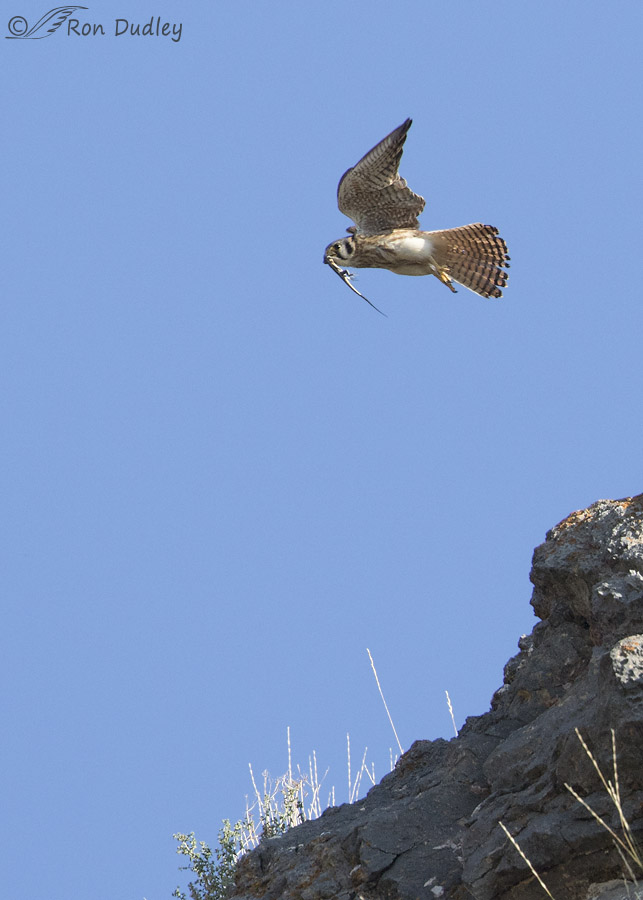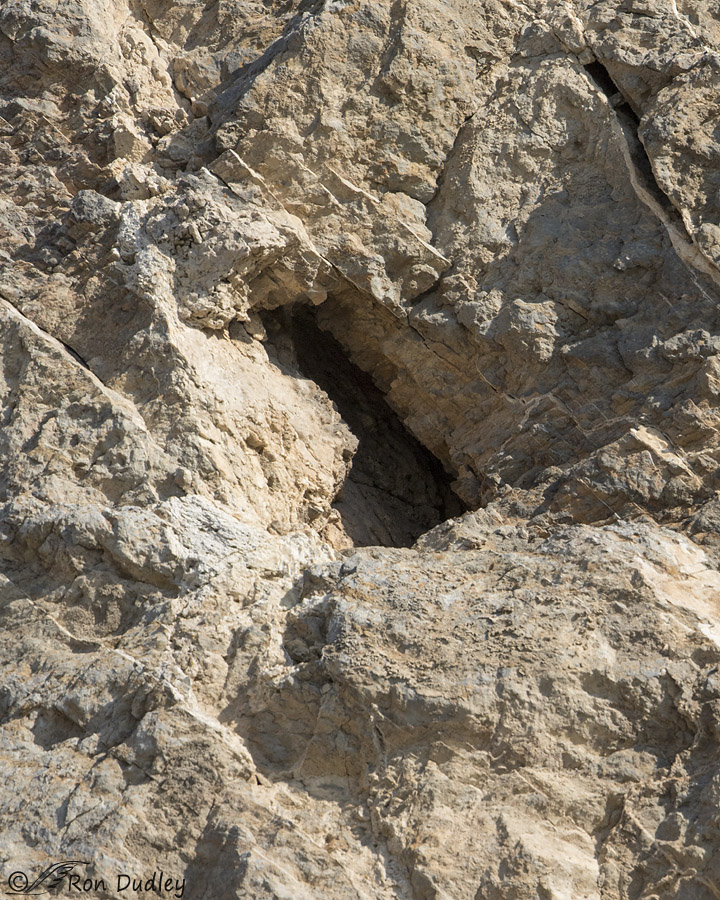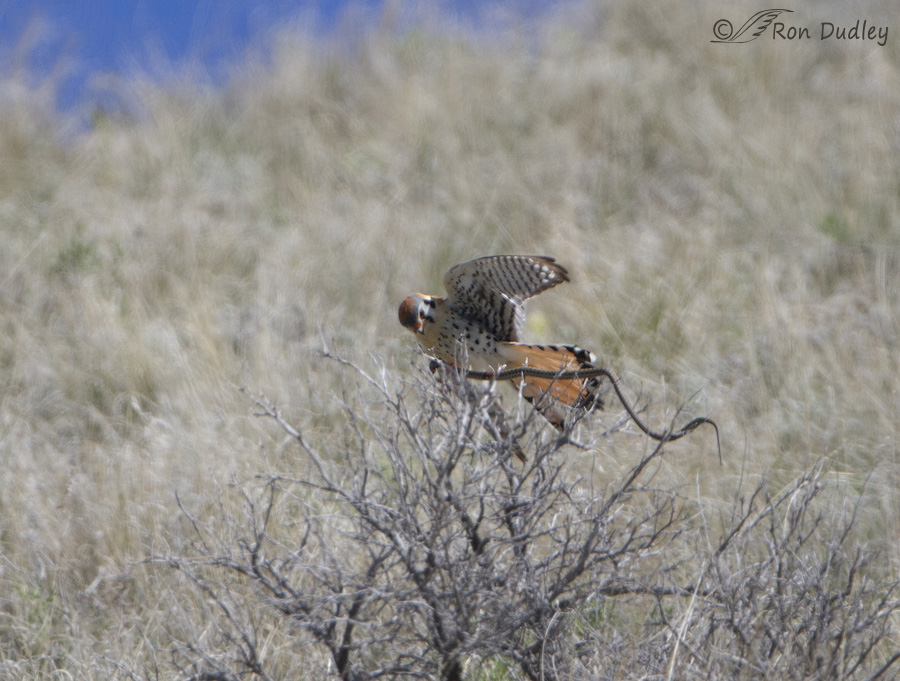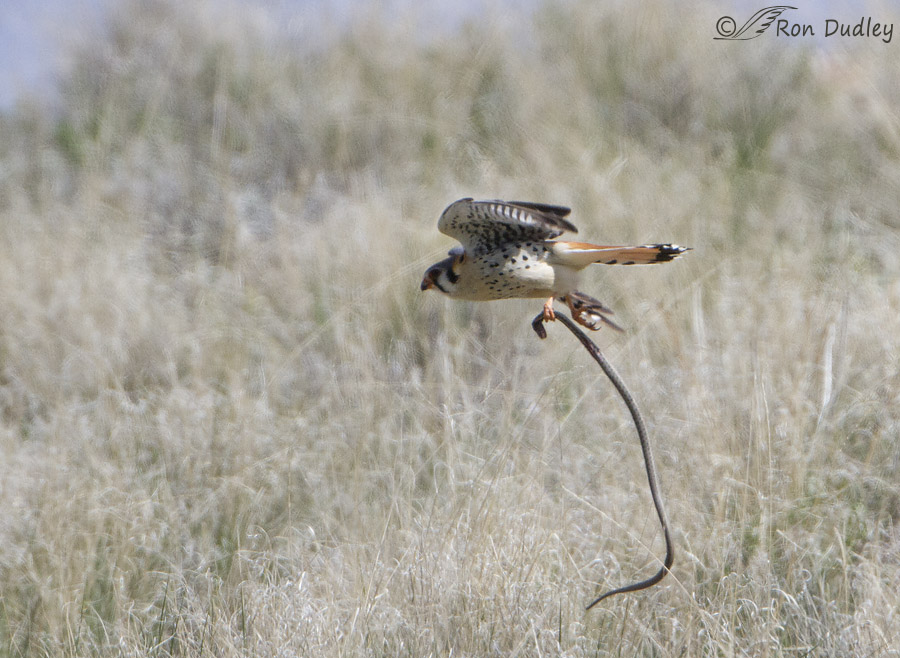Tiny kestrels preying on lizards and snakes? It does happen.
Kestrels usually prey on insects and small rodents but field studies indicate that approximately 1% of their diet consists of herptiles (amphibians and reptiles). In my personal experience with kestrels with prey most of the time I see them with voles but occasionally they have a small bird or grasshopper. But twice I’ve photographed a kestrel with a herptile (though the images are only of documentary quality because they’re very large crops).

The most recent was when I encountered this kestrel with a lizard a month ago in Box Elder County. It was using the updraft from the side of a large cliff as a hovering aid to enable it to more easily stay in flight with the extra weight it was carrying. The lizard was apparently meant for its offspring because eventually it was delivered into a nest cavity on the side of the cliff.

This is the nest cavity high on the side of the cliff. I decided to include the image even there’s no bird in it because though it is common knowledge that kestrels are cavity nesters many of us have only seen them nest in artificial nest boxes and haven’t experienced one of their natural nesting cavities. This kestrel disappeared in the cavity with the lizard and reappeared without it.

Several years ago I photographed this male kestrel in Montana’s Centennial Valley as it struggled with a relatively large snake in a dead sagebrush. This is large and awkward prey for a kestrel so when the little falcon took off with it…

the bird struggled to make any headway in flight with the snake flopping around behind. I couldn’t tell for sure if the snake was alive or dead but in the previous image blood can be seen on the beak of the kestrel so I suspect the serpent had already expired.
One of my photographic goals is to one day get quality, up-close images of a kestrel with a snake. It could happen…
Ron
PS – It’s interesting to note that kestrels have been documented with fingerling brook trout as prey. Now that would make an interesting image!


I keep learning from you- never seen this , so thanks for the lesson.
If looks could kill, kestrels would probably win talons down…they are one of the cutest, prettiest killers of all!
I agree, and so much coloring for a small bird.It amazes me.
Jean, they have outsize personalities, too.
Kestrel cavity looks a bit like a turkey vulture’s choice of home sweet home……
Thank you for including the nest cavity.
We have some spotted pardalotes who have made nests in pot plants on our back deck – but my ignorant self thought that cavity nesting was not just for the birds – but for (some) small birds.
Continuing education. For which I am very grateful.
EC, I know little about Australian birds so I had to look up the Spotted Pardolate. A colorful and tiny bird – you are so lucky to have so many great birds down there but then I guess we are up here too.
Yup. And I am lucky to have a dedicated photographer/educator to share your birds. I win.
When we were watching the nesting pair of Kestrels in our neighbor’s palm tree, lizards were often the prey the male brought to the female, in addition to small rodents and small birds. The lizard in your first shot was previously someone’s intended victim – it has a re-grown tail.
“The lizard in your first shot was previously someone’s intended victim – it has a re-grown tail.”
I wondered about that, Susan, but in the end decided that it looks more to me like the end of the tail is just in the shadow of the wing…
Ron, I checked the photo again, and still believe that the tail is regrown. The composition and color of a re-grown tail is very different from the natural tail, and there’s something about the extreme change in color, plus the smaller diameter of the tail at the point of color change that makes it look to me like it’s re-grown. But then there’s also the length of that part of the tail. I’ve encountered a lot of lizards with tails in various stages of re-growth, but have never seen one that I can recall that looked completely re-grown. With this one, I guess we’ll never know. 🙂
PS. I asked my husband to look at it, since he sees a lot of the same lizards I do, and he also believes it’s re-grown – at least in part, because he can’t see any way that the angle of the sun would cause that kind of shadow on the lizard’s tail.
I thought the same thing about the lizard’s tail…
Good eye Susan. I didn’t notice the re-grown tail.
Beautiful little birds, and mighty hunters. That is interesting to see the Kestrel wrestle with the Gopher Snake. Where there is a will, there is a way!
Thanks Ron!
How great to know that a kestrel has a nest and babies somewhere, anywhere! The more kestrels the better!!! Didn’t know they nested in such places…thought they nested in cavities in trees. Snakes can move, whip around, so long after being “killed”, it must be very difficult prey to handle,and transport, to their babies. These pictures remind me of a Golden Eagle that flew up in front of my car on the Pine Ridge Rez,as the sun was beginning to set, carrying a big snake…can’t remember now if it was in its talons or beak, but it was an impressive sight…
Patty, I don’t think they’re particularly fussy about what the cavity is in as long as it suites their needs. I do hope that some young birds fledged out of this one…
A cavity is in the eye of the beholder. The pair of Kestrels that nested in our neighborhood chose the hanging down dead leaves of a palm tree as their ‘cavity’. They used it for two years, and successfully raised at least 5 babies there. To our dismay, they chose to nest elsewhere this year… and we have really missed them. Given the protracted period of getting the eggs to hatch and then raising the babies, and their great personalities, they provided quite a lot of entertainment for us. And joy.
Interesting, Susan. As far as I know a nest site such as you describe would be unusual for kestrels. I’m glad you could enjoy them for as long as you did.
Thanks for including the photo of the natural rock nesting site–I had no idea that raptors used such a place for their families…..your blog is always such a
source of education for me !
Thanks very much, Kris. I appreciate knowing that the nesting site photo was interesting for you.
The kestrel is one of my favorites. I think they are one of the prettiest!
There’s certainly no denying that, Stephanie!
Oh it will happen, I’m convinced of that Ron, you will be successful!
Great shots, Love kestrels, as you may remember I flew a female kestrel many years ago. It is a real treat to see where they nest and what their prey on in the western part of our country. Many thanks for sharing!
Yes, I do remember that you flew a kestrel, Dick. I once photographed an escaped falconry kestrel that was eventually recovered, partly with the aid of my photographs, so the “owner” of the bird brought it to my home for a “thank you” visit. That was a special half-hour.
I appreciate the feedback on the nest cavity photo. I almost didn’t include it but thought some might like to see what a natural kestrel nesting cavity can look like. Thank you.